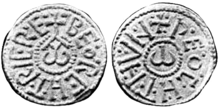Beorhtric of Wessex
| Beorhtric | |
|---|---|

Coin of Beorhtric, probably minted at Winchester c. 795
|
|
| King of Wessex | |
| Reign | 786–802 |
| Predecessor | Cynewulf |
| Successor | Egbert |
| Consort | Eadburh |
| House | Wessex |
Beorhtric (also Brihtric; meaning 'Magnificent ruler') was the King of Wessex from 786 to 802, succeeding Cynewulf.
Beorhtric was a close ally of Offa, King of Mercia. In 787 Beorhtric held the Synod of Chelsea jointly with Offa, and in 789 he married one of Offa's daughters, Eadburh. Land that had traditionally been on the borders of Mercia and Wessex were administered by the Mercian court, as is seen in Charters of Offa, and his son Ecgfrith. West Saxons seem to have used Offa's currency: a recent survey of early medieval single coin finds reveals a trail of Offa pennies running from the Upper Thames to Wareham, a site connected with Beorhtric.
It was during Beorhtric's reign that the Anglo-Saxon Chronicle records the first Viking raids on England occurred. In 789, they landed on the Dorset coast, near the Isle of Portland, where they killed a royal official, the shire reeve.
After Offa's death in 796, Mercian power over England was weakened, and Beorhtric may have exercised more independence during this period. The only two West Saxon coins to have survived from Beorhtric's reign were produced at this time, suggesting that he had established a new mint. One of these coins was found in 1854, two miles outside of Andover. Within a few years, Offa's successor, Coenwulf, had restored Mercia's position. After 799, Beorhtric's relationship with the Mercians seems to have been similar to the situation before Offa's death.
In later years Asser, a scholar at Alfred the Great's court, recorded the story that Beorhtric had died from being accidentally poisoned by his wife, Eadburh. She fled to a nunnery in Francia, from which she was later ejected after being found with a man. The provenance of this story is dubious. The Anglo-Saxon Chronicle records that Beorhtric was buried at Wareham in 802, possibly at the church of Lady St. Mary.
...
Wikipedia
